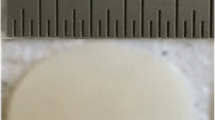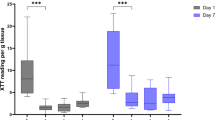Abstract
Purpose
The purpose of this study was to find a suitable method of labelling cartilage samples for the measurement of distraction distances in biomechanical testing.
Methods
Samples of bovine cartilage were labelled using five different methods: hydroquinone and silver nitrate (AgNO3), potassium permanganate (KMnO4) with sodium thiosulphate (Na2S2O3), India ink, heat, and laser energy. After the labelling, we analysed the cartilage samples with regard to cytotoxity by histochemical staining with ethidiumbromide homodimer (EthD-1) and calcein AM. Furthermore, we tested cartilages labelled with India ink and heat in a T-peel test configuration to analyse possible changes in the mechanical behaviour between marked and unlabelled samples.
Results
Only the labelling methods with Indian ink or a heated needle showed acceptable results in the cytotoxity test with regard to labelling persistence, accuracy, and the influence on consistency and viability of the chondrocytes. In the biomechanical T-peel configuration, heat-labelled samples collapsed significantly earlier than unlabelled samples.
Conclusion
Labelling bovine cartilage samples with Indian ink in biomechanical testing is a reliable, accurate, inexpensive, and easy-to-perform method. This labelling method influenced neither the biomechanical behaviour nor the viability of the tissue compared to untreated bovine cartilage.





Similar content being viewed by others
References
Ahsan T, Sah RL (1999) Biomechanics of integrative cartilage repair. Osteoarthr Cartil 7(1):29–40
Reindel ES, Ayroso AM, Chen AC et al (1995) Integrative repair of articular cartilage in vitro: adhesive strength of the interface region. J Orthop Res 13(5):751–760
Englert C, Greiner G, Berner A, Hammer J (2008) T-peel test for the analysis of articular cartilage integration. Stud Health Tech Informat 133:95–102
Fierlbeck J, Hammer J, Englert C, Reuben RL (2006) Biomechanical properties of articular cartilage as a standard for biologically integrated interfaces. Technol Health Care 14(6):541–547
Schmitz N, Laverty S, Kraus VB, Aigner T (2010) Basic methods in histopathology of joint tissues. Osteoarthr Cartil 18(Suppl 3):S113–S116
Salerno A, Trent R, Jackson PJ, Cook MG (1995) A rapid and safe method to fix India ink on specimen resection margins. J Clin Pathol 48:689–692
Lee JH, Fitzgerald JB, Dimicco MA, Grodzinsky AJ (2005) Mechanical injury of cartilage explants causes specific time-dependent changes in chondrocyte gene expression. Arthritis Rheum 52(8):2386–2395
Spahn G, Wittig R (2003) Biomechanical properties (compressive strength and compressive pressure at break) of hyaline cartilage under axial load. Zentralbl Chir 128(1):78–82
Voss JR, Lu Y, Edwards RB et al (2006) Effects of thermal energy on chondrocyte viability. Am J Vet Res 67(10):1708–1712
Lu Y, Edwards RB 3rd, Nho S et al (2002) Lavage solution temperature influences depth of chondrocyte death and surface contouring during thermal chondroplasty with temperature-controlled monopolar radiofrequency energy. Am J Sports Med 30(5):667–673
Jones N, Sviridov A, Sobol E et al (2001) A prospective randomised study of laser reshaping of cartilage in vivo. Lasers Med Sci 16(4):284–290
Rosa SC, Gonçalves J, Judas F et al (2009) Assessment of strategies to increase chondrocyte viability in cryopreserved human osteochondral allografts: evaluation of the glycosylated hydroquinone, arbutin. Osteoarthr Cartil 17(12):1657–1661
Acknowledgement
We would like to thank Richard Kujat and Sandra Rohde in the experimental laboratory of the trauma unit of the Medical Centre of the University of Regensburg for their kind support. We are grateful to the University Medical Centre Regensburg for their financial support within the ReForM-C grant as well as to the DFG for their financial support for publication.
The linguistic assistance of Ms Monika Schoell is gratefully acknowledged. We state no conflict of interest.
Author information
Authors and Affiliations
Corresponding author
Rights and permissions
About this article
Cite this article
Pfeifer, C., Müller, M., Prantl, L. et al. Cartilage labelling for mechanical testing in T-peel configuration. International Orthopaedics (SICOT) 36, 1493–1499 (2012). https://doi.org/10.1007/s00264-011-1468-3
Received:
Accepted:
Published:
Issue Date:
DOI: https://doi.org/10.1007/s00264-011-1468-3




